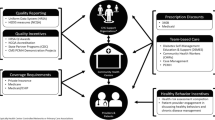Abstract
This essay examines the debate surrounding New York City’s controversial diabetes registry program. Exploring the tensions between public health officials and privacy advocates, the article explores how diabetes is imagined in the public sphere. Although rhetorics underscoring privacy may seem the more progressive discourse, I argue New York City’s Department of Health and Mental Hygiene has the more forward-looking plan, attempting to reconstitute diabetes not as a chronic condition necessitating individual management but as a disease that requires systemic intervention.
Similar content being viewed by others
Notes
Mitchell and McTigue (2007, 401-402) rightfully point out that the CDC has monitored noninfectious agents, but these outbreaks (gastrointestinal symptoms, melanoma, and mesothelimoa) involved environmental causal agents (such as methyomyl, ultraviolet light, and asbestos).
Under the New York plan, scores over 9 % constitute “poorly controlled” blood sugar. Scores under 7 % are defined as good control.
For more on the relationship among liberalism and civic humanism, see Beiner 2008; Pocock 1992.
This essay explores texts that engage New York City’s DOHMH’s diabetes program and that offer structured coherence to the thematic narratives about “the debate” surrounding the registry. This included representative texts from Public Health journals, publications posted on DOHMH’s web site, and Law journals. Staying close to the emergent themes of “epidemic” and “privacy” from an initial reading of texts, a search of EBSCO and Lexis/Nexis databases was used to employ additional evidence. To further enhance this study, an interview was conducted with Dr. Shadi Chamany to clarify materials found in the literature.
In 2000, the average length of a diabetes-related hospital stay was 7.9 days, with the average charge of $17,800 per stay. There is a slow but steady trend of declining length of hospital stay and increasing charges per stay. In 1997, the average hospital stay was 8.9 days and the average charge was $15,400. See New York State Strategic Plan 2008.
Notably, poverty alone does not seem to account for the significant rates of diabetes in the city. As one public health scholar put it: “31 % of diabetic patients in commercial managed care and 42 % in Medicaid Managed Care in New York State have an A1C of greater than 9 %, indicative of poor control. Yet only 10 % of people with diabetes are aware of their A1C levels.” See Fairchild 2006, 175.
The New York program was modeled in part after a successful registry in Vermont where patients volunteered to participate in the program. There have also been examples of registries run internally by hospitals that have been met with success.
Segal borrows heavily from Kenneth Burke, who has famously quipped that “observations” are “but implications of the particular terminology in terms of which the observations are made. In brief, much of what we take as observations about ‘reality’ may be but the spinning out of possibilities implicit in our particular choice of terms” (1966, 46).
For many years public health departments avoided addressing chronic conditions such as diabetes because they did not mimic other disease models. In the instance of cancer, for example, there was a limited mission of looking at incidence and prevalence. See Fairchild and Alkon 2007.
To alleviate these concerns, Krent recommended five “safety” implementations: that the statute expressly state that no information contained in the registry may be subject to subpoena (as the city did with HIV and other sexually transmitted infections); that the notification system be based on affirmative consent; that patients be given the right to opt-out of future research unless consent is expressively given; that employers and insurance companies be forbidden to inquire about A1C scores; and that physician names not be disclosed.
On contract metaphors, see Somers 2008.
Chamany took issue with these arguments, asserting the law and internal DOHMH protocols protected individual information.
Krent notes the federal government has been given broad authority by the Supreme Court to participate in surveillance programs. Whalen v. Rose (1977) remains the sole Supreme Court case that allowed for public health surveillance. See Fairchild, Bayer, and Colgrove 2007, 27-28.
I want to thank Bruce Gonbeck for his insights on this point.
Staff and budget deficiencies may mean the program alone is not enough to combat diabetes in the city. When the program was first introduced, some were skeptical because the initiative offered no resources for diabetes treatment or services. At the program’s founding, it only had three staff members and a $950,000 annual budget. Compare this to tuberculosis, which infected only 1000 New Yorkers the same year, had a $27 million budget, and a staff of nearly 400. See Goldman et. al. 2008, 809; Steinbrook 2006, 548; Bloomgarden, 2006.
I originally found this quotation in Fairchild and Alkon 2007, 568.
For more on “infantile citizenship” see Berlant 1997.
Author information
Authors and Affiliations
Corresponding author
Additional information
The author would like to thank Isaac West, Suzanne Enck, and the anonymous reviewer for their feedback on previous drafts of this essay.
Rights and permissions
About this article
Cite this article
Bennett, J.A. Troubled Interventions: Public Policy, Vectors of Disease, and the Rhetoric of Diabetes Management. J Med Humanit 34, 15–32 (2013). https://doi.org/10.1007/s10912-012-9198-0
Published:
Issue Date:
DOI: https://doi.org/10.1007/s10912-012-9198-0




